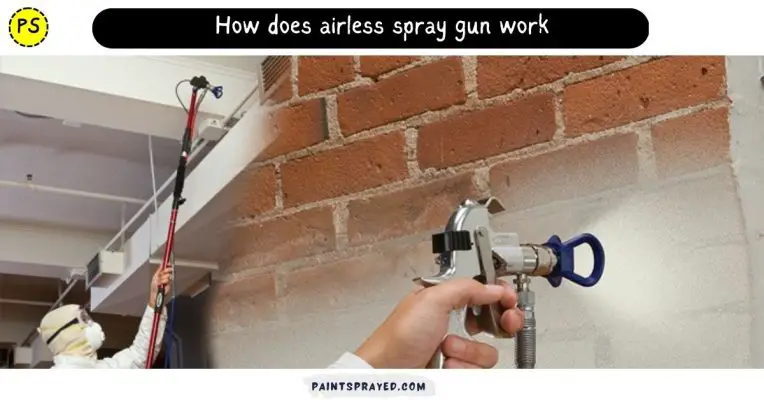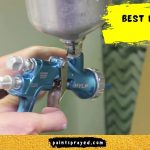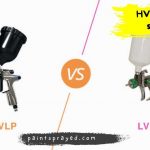An airless spray gun uses a high-pressure pump to atomize and propel paint or other materials through the gun and onto a surface.
The pump, which is typically powered by an electric motor, pressurizes the material, breaking it up into small droplets.
These droplets are then propelled through the gun’s tip and onto the surface being painted. This guide on How does airless spray gun work is especially for newbies.
How does airless spray gun work?
An airless spray gun is a type of paint-spraying tool that uses a high-pressure pump to atomize and propel paint or other materials through the gun and onto a surface.
This type of spray gun has many advantages over traditional air spray guns, including the ability to handle thicker materials and the ability to apply a more even and consistent coating.
However, there are also some limitations to using an airless spray gun, such as overspray and difficulty in controlling the gun.
In this article, we will take a closer look at how an airless spray gun works, its benefits and limitations, and how to use it effectively.
The basic principle behind an airless spray gun is the use of a high-pressure pump to pressurize the material.
This pump, which is typically powered by an electric motor, increases the pressure of the paint or other material to a level where it can be broken up into small droplets.
These droplets are then propelled through the gun’s tip and onto the surface being painted.
The high pressure of the pump allows for a more even and consistent coating, as well as the ability to handle thicker materials than traditional air spray guns.
One of the main benefits of an airless spray gun is its ability to handle thicker materials.
Traditional air spray guns rely on compressed air to atomize the paint or other material, which can be limiting when it comes to handling thicker materials.
An airless spray gun, on the other hand, uses its own high-pressure pump to pressurize the material, which allows for the atomization of even the thickest materials.
This makes it an ideal tool for painting large surfaces, such as walls and ceilings, as well as for applying heavy-duty coatings, such as industrial coatings and epoxies.
Another advantage of an airless spray gun is that it can apply a more even and consistent coating.
The high pressure of the pump allows for the atomization of the material into smaller droplets, which can then be more easily applied to the surface.
This results in a more even and consistent coating, with less overspray and less waste of material.
An airless spray gun also does not require a compressed air source, as it uses its own pump to pressurize the material.
This makes it more portable and easier to use in remote locations or on job sites without access to a compressed air source.
This feature makes it a great tool for professionals who work on different job sites, it is easy to carry around, and it doesn’t require a complicated setup.
However, there are also some limitations to using an airless spray gun. One of the main issues is overspray, which is a waste of material and can create a mess.
Overspray occurs when the high pressure of the pump propels droplets of paint or other material beyond the intended surface, resulting in a waste of material and a messy work area.
Another limitation of an airless spray gun is that the high pressure can cause the gun to vibrate, making it difficult to control.
This can result in an uneven coating and a poor-quality finish.
To overcome this limitation, it is important to choose a gun with a low vibration level and to practice using the gun to get a feel for its handling.
To use an airless spray gun effectively, it is important to follow proper safety precautions.
This includes wearing protective gear, such as goggles and a respirator, to protect yourself from overspray and fumes.

It is also important to keep the work area clean and well-ventilated, to avoid inhaling fumes and to minimize the risk of fire or explosion.
Additionally, it is important to properly maintain the airless spray gun by cleaning it after each use.
How does electric airless paint sprayer work?
An electric airless paint sprayer works by using a high-pressure pump to force paint through a small tip and onto the surface being painted.
The pump creates a fine mist of paint that can be easily adjusted for the desired coverage and flow.
Electric airless paint sprayers are typically used for large surfaces, such as walls and buildings, and can save time and effort compared to using a brush or roller.
They can also produce a more consistent finish.
Are airless spray guns any good?
Airless spray guns can be a good choice for certain painting projects. They are typically used for larger surfaces and can cover them quickly and evenly, with minimal overspray.
They can also be used with a wide variety of paint types, including latex, oil-based, and enamels. Additionally, they can save time and effort compared to using a brush or roller.
However, airless spray guns can be more difficult to control than other types of paint application methods, and they may produce more overspray.
They also require more maintenance and cleaning than other methods.
Additionally, they can be quite loud and produce more overspray than other methods, which can be a concern for indoor use.
In summary, airless spray guns can be a good choice for certain painting projects, but they have some limitations and may not be the best option for every situation.
It’s important to consider the size and type of the surface to be painted, as well as the type of paint and the desired finish, before deciding on a paint application method.
Does an airless sprayer use more paint?
An airless sprayer can use more paint than other application methods, such as brushes or rollers.
This is because an airless sprayer atomizes the paint into very fine droplets, which can result in overspray and wasted paint.
Additionally, an airless sprayer typically operates at a higher pressure than other methods, which can also result in more paint being used.
However, it’s worth noting that an airless sprayer can also be more efficient than other methods, especially for larger surfaces or surfaces with complex shapes.
It can cover the surface more quickly and evenly than a brush or roller, which can reduce the amount of time and effort required for the job.
To minimize paint waste when using an airless sprayer, you should adjust the pressure and tip size to match the type and viscosity of the paint, as well as the surface being painted.
Additionally, you should practice proper spraying techniques and use appropriate protective equipment to minimize overspray.

In summary, an airless sprayer can use more paint than other methods, but it can also be more efficient, especially for larger or more complex surfaces.
It’s important to consider the size and type of the surface, as well as the type of paint, before deciding on a paint application method.
How do you use an airless spray gun?
Using an airless spray gun involves several steps, including preparing the surface to be painted, preparing the paint, setting up the spray gun, and applying the paint. Here is a general overview of the process:
- Prepare the surface: Clean and repair any surfaces that need to be painted. Make sure the surface is dry and free of dust, grease, or other contaminants.
- Prepare the paint: Mix the paint thoroughly and strain it to remove any lumps or debris. Pour the paint into the spray gun’s paint container.
- Set up the spray gun: Attach the spray tip and guard to the spray gun. Adjust the pressure and flow rate to match the type and viscosity of the paint, as well as the surface being painted.
- Apply the paint: Hold the spray gun about 12 to 16 inches away from the surface and overlap each pass slightly to ensure even coverage. Move the gun in a side-to-side motion, keeping the gun moving at all times to avoid drips.
- Clean the spray gun: After you have finished painting, it is important to clean the spray gun thoroughly to ensure it will be ready for next time.
It’s important to practice proper spraying techniques and use appropriate protective equipment.
Such as a respirator, goggles, and protective clothing to minimize overspray and protect yourself from inhaling paint fumes.
It’s also worth noting that before you start any painting job, it’s a good idea to practice on a piece of scrap material or an inconspicuous area to get a feel for the spray gun.s
And to check that the paint is atomizing correctly and the desired finish is achieved.
Conclusion on How does airless spray gun work
In conclusion, an airless spray gun is a powerful tool that can save time and labor on large painting projects, producing a smoother and more professional-looking finish.
However, it is important to consider the advantages and disadvantages of using an airless spray gun before deciding to use one.
With proper training and safety measures, an airless spray gun can be a great addition to any painter’s toolbox.

Matthew Edward is a professional painter who loves to paint and wants to share useful tips and tricks which he had learned in many years of experience in painting. He also used many products that can be used for painting he has tried and tested each and every product to give an unbias opinion about it in his review. This blog is very useful for those newbies who want to learn painting without making mistakes.






